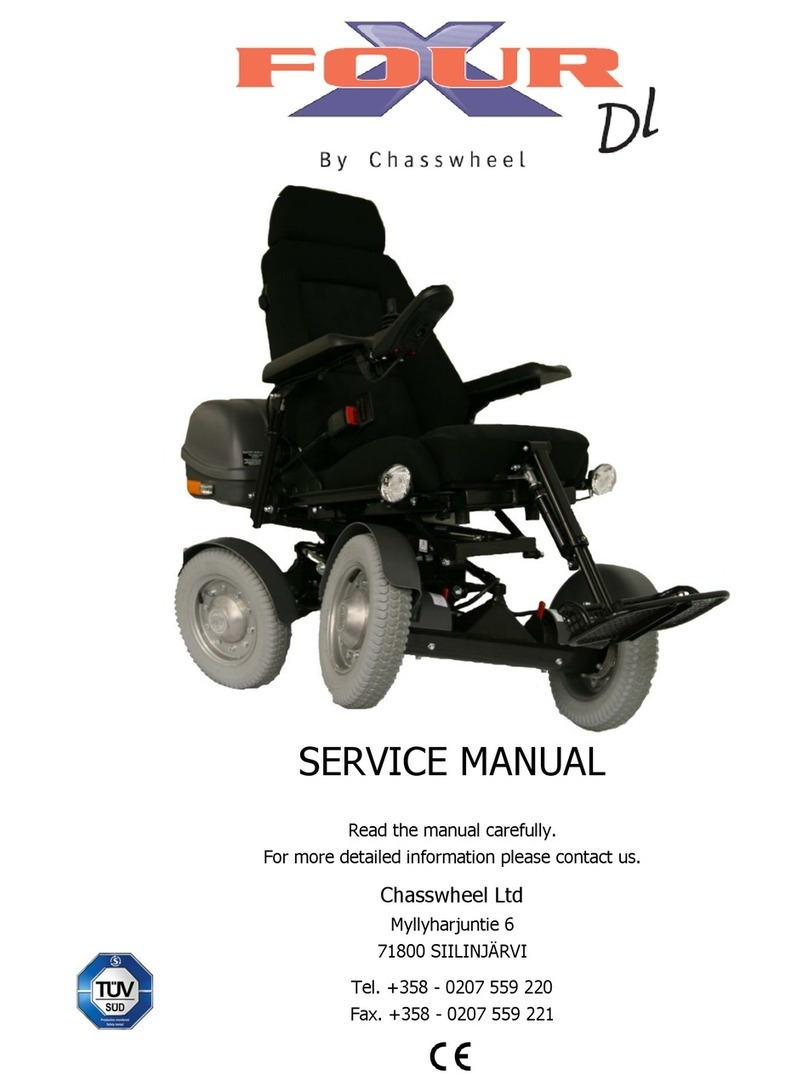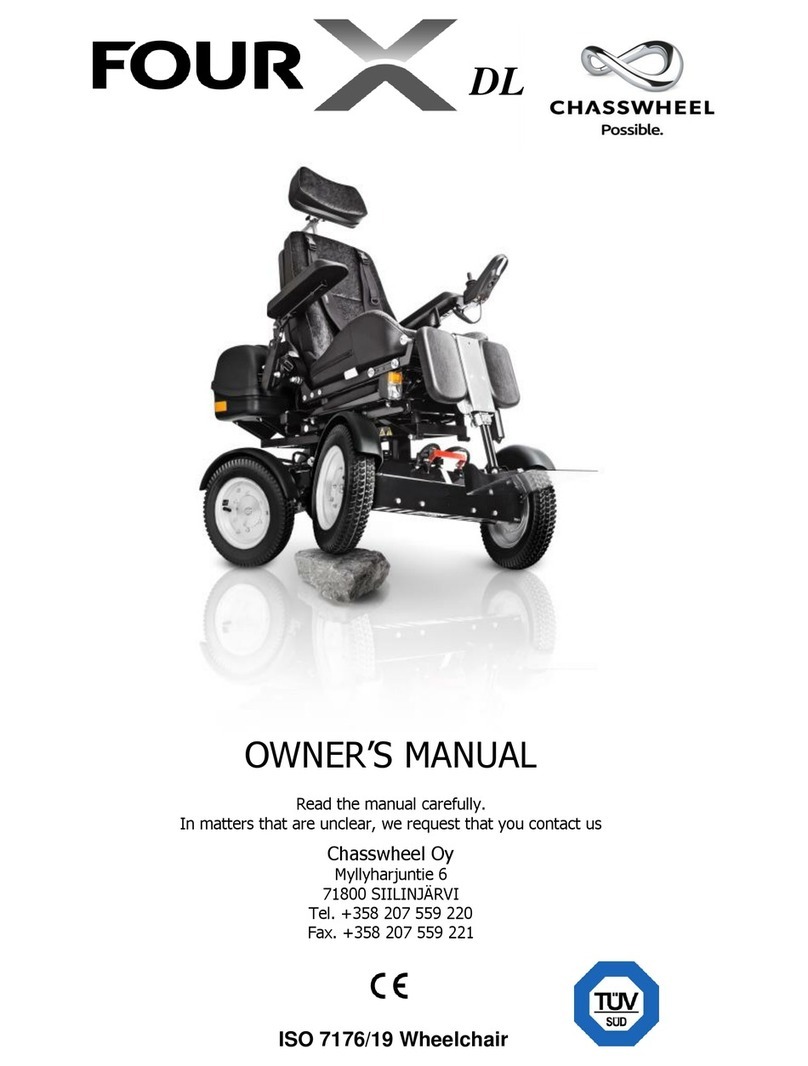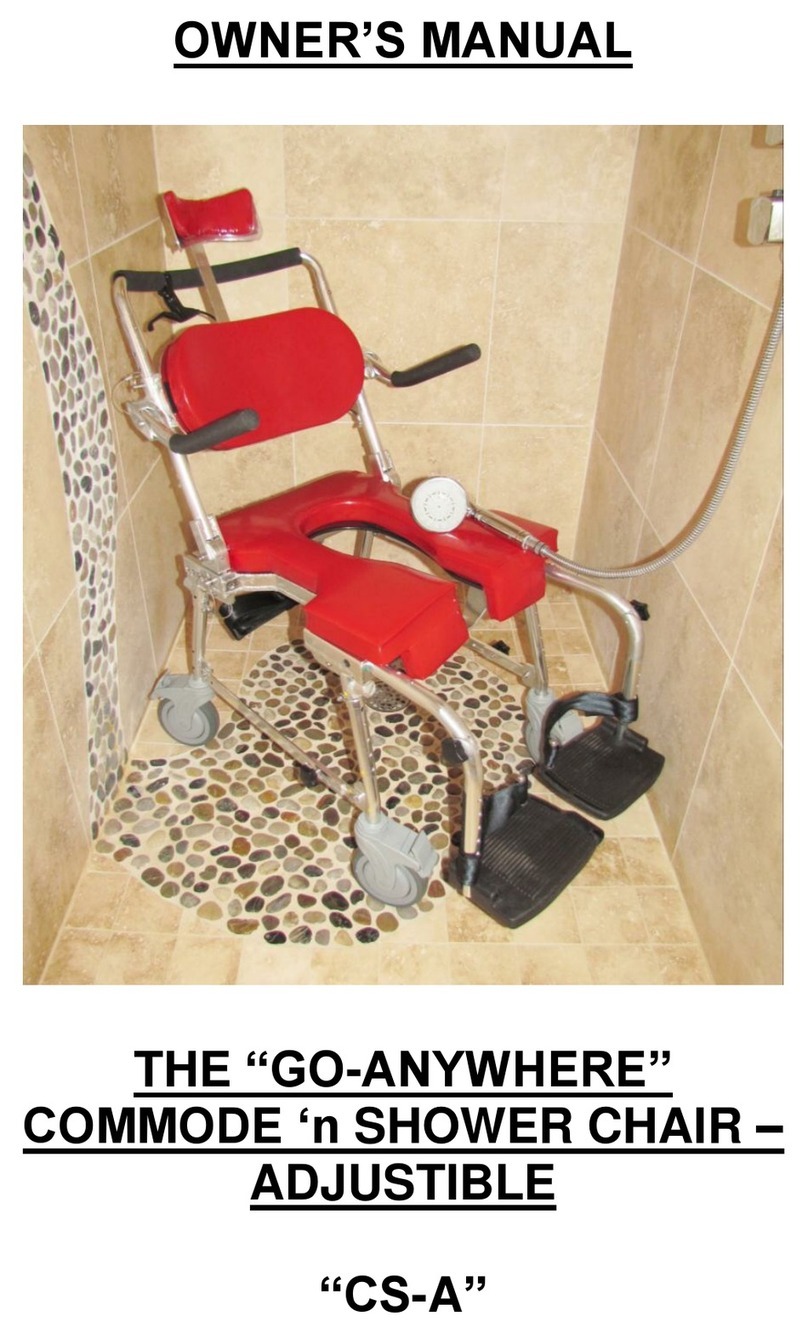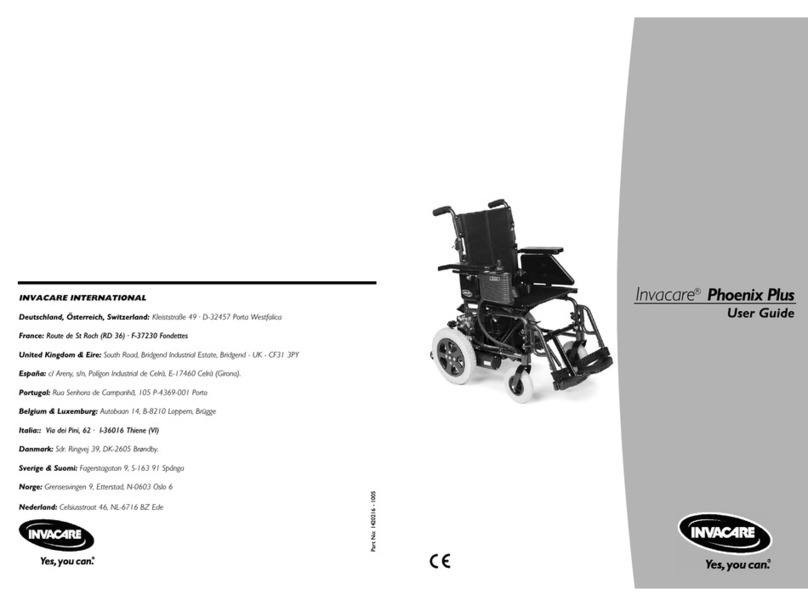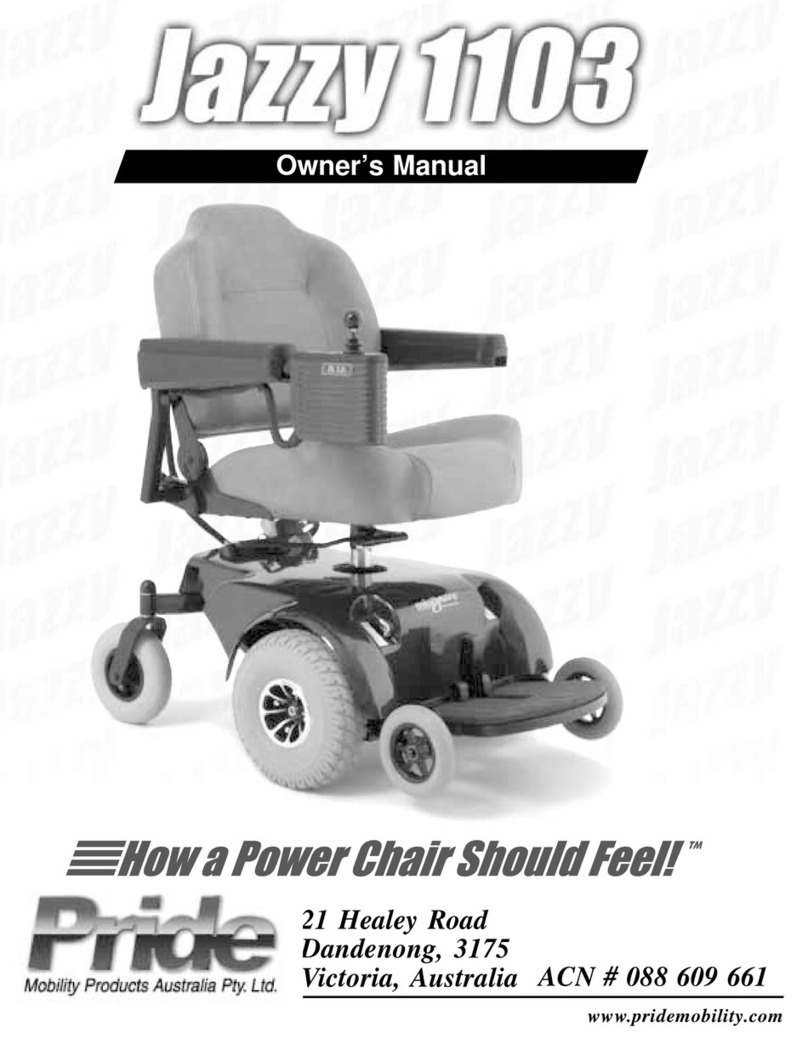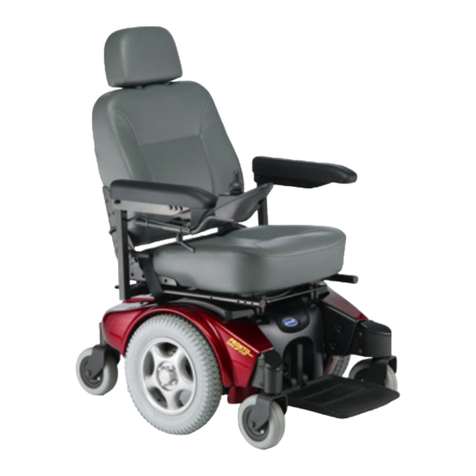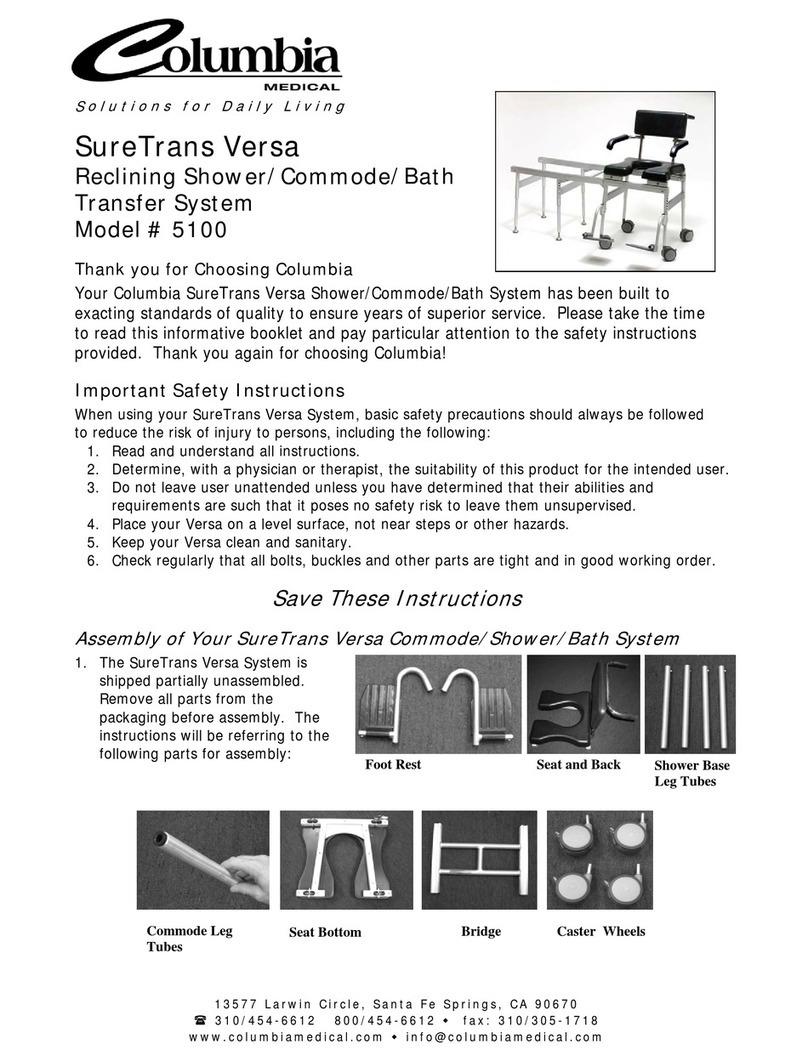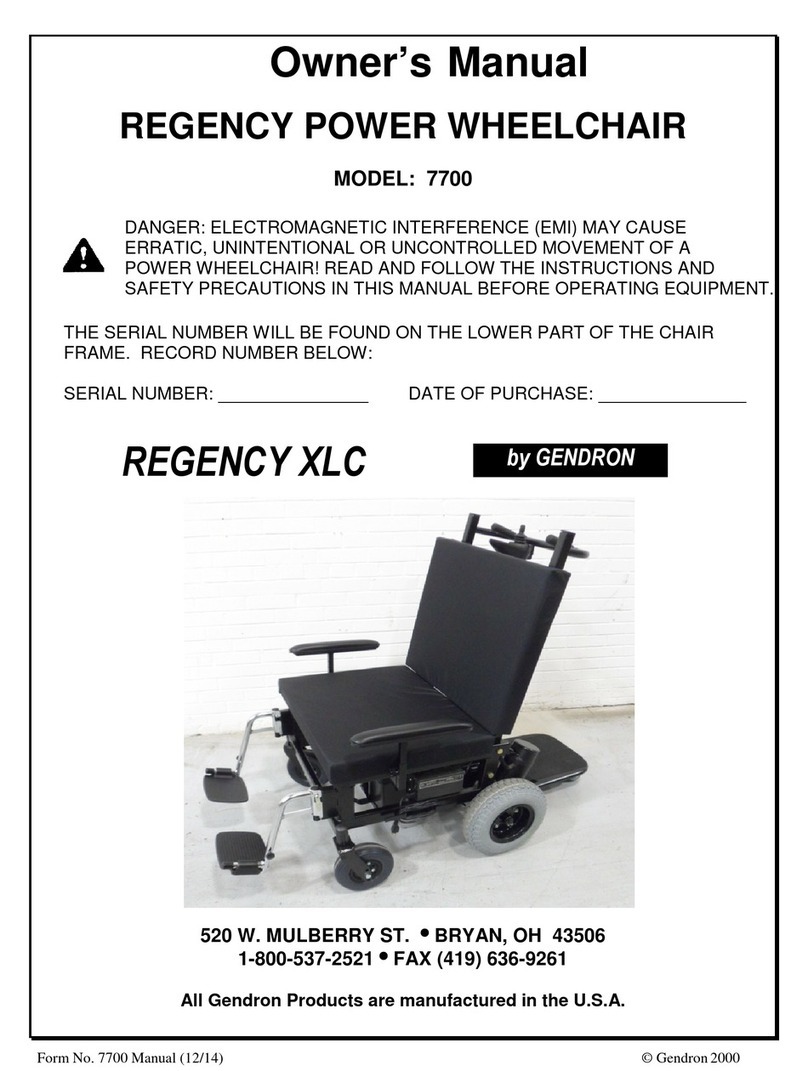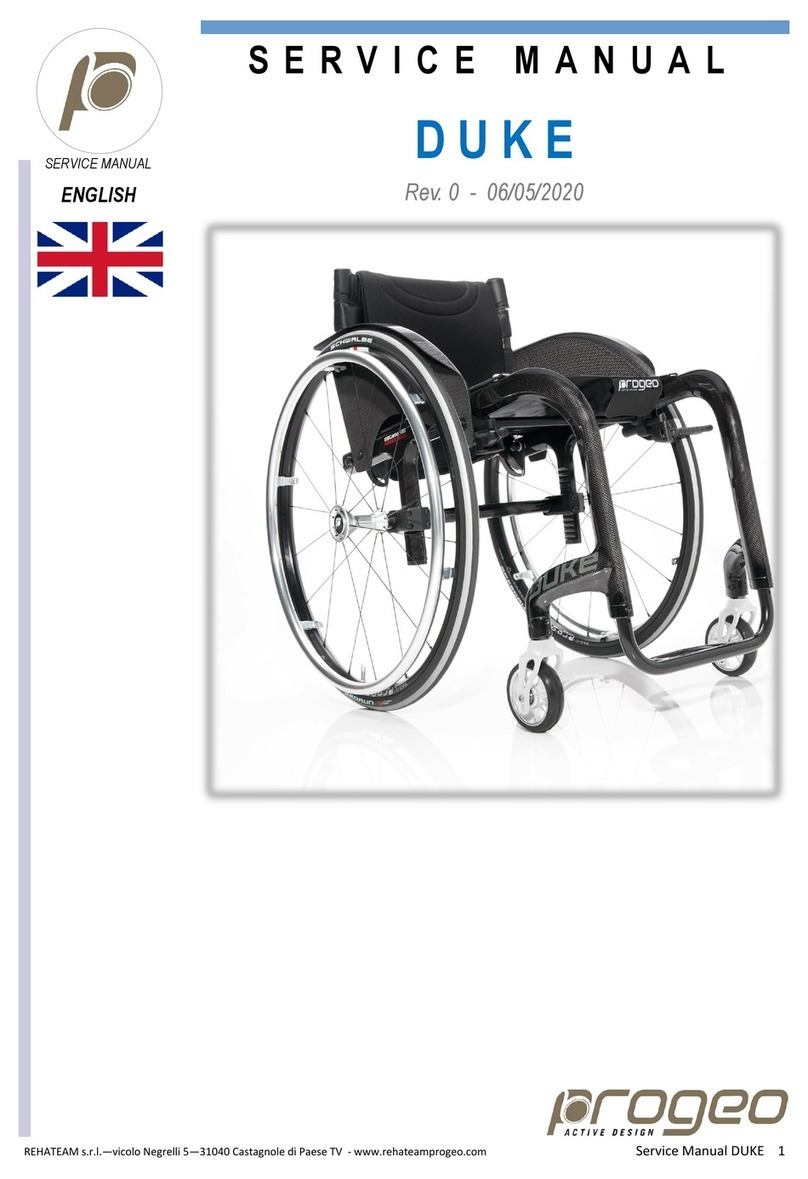Chasswheel Four X DL User manual

OWNER’S MANUAL
Read the manual carefully.
In matters that are unclear, we request that you contact us
Chasswheel Oy
Myllyharjuntie 6
71800 SIILINJÄRVI
Tel. +358 207 559 220
Fax. +358 207 559 221
ISO 7176/19 Wheelchair
DL

R-NET www.chasswheel.com
rev. 1 2014-05-08
2
Valued CW3 FOUR X DL user,
We welcome you among CW3 FOUR X DL users. We appreciate your confidence in us and we are
convinced that your recently received electric wheelchair will fulfil your expectations. The most
important aims in the planning and manufacture of the CW3 FOUR X DL are to offer the freedom to
move for every person and thus improve their quality of life. Your CW3 FOUR X DL electric
wheelchair guarantees you a smooth ride both on and off-road. Now there's no need to plan your
route according to where your wheelchair can get, but you can now go wherever you wish. The CW3
FOUR X DL goes agilely up and downhill and climbs up street kerbs easily. Snow, mud or tree roots
are no longer obstacles for you.
By paying attention to our user's manual, you will learn how to use the CW3 FOUR X DL electric
wheelchair safely for your long-term benefit.
We wish you pleasant riding on the CW3 FOUR X DL.

R-NET www.chasswheel.com
rev. 1 2014-05-08
3
WARRANTY
Chasswheel Oy guarantees a two (2) year warranty for the CHASSWHEEL CW3 FOUR X DL electric
wheelchair’s frame and chassis, the driving control system, driving motors, and the seat. Batteries
and charging appliances are not included in the warranty. On every wheelchair there is a model plate
which shows a unique serial number.
This warranty covers faults that occur in normal operation of the wheelchair. The warranty does not
cover faults caused by normal wear and improper or lack of maintenance as indicated in the owner's
manual and the service instructions.
Furthermore, the warranty does not cover faults originating from overloading or incorrect
programming. Normal wear occurs in parts such as tyres, rubber mountings, leaf springs, joints and
slide surfaces. Increased noise of the driving motors is also caused by normal wear.
Indirect expenses incurred in dealing with faults are not included in the warranty.
Wheelchair frame number: ____________
Date and signature: ______________________________________________________________

R-NET www.chasswheel.com
rev. 1 2014-05-08
4
DECLARATION OF CONFORMITY
The manufacturer:
Chasswheel Oy
Myllyharjuntie 6
71800 SIILINJÄRVI
Finland
declares that the CHASSWHEEL CW3 FOUR X DL electrically powered wheelchair
conforms to the following standard requirements
93/42/EEC
EN 12184
Siilinjärvi 8.7.2009
Risto Heikkinen
Managing Director

R-NET www.chasswheel.com
rev. 1 2014-05-08
5
CONTENTS
1 SAFETY RECOMMENDATIONS..................................................................................................6
APPLICABILITY FOR DIFFERENT TYPE OF USERS ..................................................................... 6
SAFE DRIVING.......................................................................................................................6
SAFE USE AND SERVICE.........................................................................................................8
2 EQUIPMENT AND THEIR USE................................................................................................. 11
2.1 DRIVING CONTROLLER USE ............................................................................................... 12
2.2 BACK REST, HEAD SUPPORT, ARM REST AND FOOT REST ADJUSTMENTS ............................. 17
BACK REST ADJUSTMENT..................................................................................................... 17
MANUALLY ADJUSTABLE BACK REST..................................................................................... 17
ELECTRICALLY ADJUSTABLE BACK REST ............................................................................... 17
HEAD SUPPORT ADJUSTMENT .............................................................................................. 17
ARM REST ADJUSTMENT ...................................................................................................... 18
ADJUSTMENT OF A MANUALLY ADJUSTABLE FOOT REST........................................................ 19
ADJUSTMENT OF AN ELECTRICALLY ADJUSTABLE FOOT REST WITH LENGHT COMPENSATION 19
2.3 OTHER DEVICES AND SUPPLIES ......................................................................................... 20
SEAT BELT USE ................................................................................................................... 20
LIGHTING DEVICES ............................................................................................................. 20
TYRES................................................................................................................................. 20
BATTERIES.......................................................................................................................... 20
BATTERY RECHARGING........................................................................................................ 21
FUSES................................................................................................................................. 21
3 DRIVING THE WHEELCHAIR.................................................................................................. 22
MOUNTING TO THE WHEELCHAIR ........................................................................................ 22
DRIVE PRACTICE ................................................................................................................. 23
BALANCE ADJUSTMENT........................................................................................................ 24
CLIMBING STEPS ................................................................................................................. 25
4 FREEWHEELING ................................................................................................................... 26
5 TRANSPORTATION AND PACKAGING OF THE WHEELCHAIR..................................................... 26
6 WHEELCHAIR SERVICING...................................................................................................... 27
DAILY INSPECTIONS............................................................................................................ 27
WEEKLY INSPECTIONS......................................................................................................... 28
CLEANING AND DISINFECTION THE WHEELCHAIR................................................................. 28
MEASURING THE TYRE AIR PRESSURE.................................................................................. 28
TYRE EXCHANGE ................................................................................................................. 29
DISCONNECTING THE BATTERIES ........................................................................................ 29
INSTALLING THE BATTERIES................................................................................................ 29
CHANGING THE LAMPS ........................................................................................................ 30
SPARE PART INFORMATION ................................................................................................. 30
ELECTRIC MALFUNCTION..................................................................................................... 31
PROGRAMMING ................................................................................................................... 31
RE-USE AND RECYCLING...................................................................................................... 31
7 WHEELCHAIR STORAGE........................................................................................................ 32
8 Use of the wheelchair as a seat in a vehicle ............................................................................ 32
9 TECHNICAL INFORMATION CW3 FOUR X DL........................................................................... 35
10 SERVICE CARD OF FOUR X DL WHEELCHAIR ........................................................................ 36

R-NET www.chasswheel.com
rev. 1 2014-05-08
6
1 SAFETY RECOMMENDATIONS
Read this manual carefully before using the wheelchair. It will guide you on flexible and safe use of
the wheelchair and advise you on the procedures for problem situations. Please contact the supplier
if you have any further questions.
The wheelchair is intended for outdoor use, where it can cross obstacles in normal outdoor
conditions and drive on uneven ground. The wheelchair can also be used in suitable indoor premises.
APPLICABILITY FOR DIFFERENT TYPE OF USERS
Wheelchair is intended for person who has active life with the family. Wheelchair is also suitable for
persons who want to move and act independently both in the city and in the countryside.
The wheelchair is intended for users weighing not more than 125kg and having the ability to learn
the correct use of the equipment and the physical preconditions for using the controlling system and
the necessary equipment.
Wheelchair is perfectly suitable for persons whose injury / disease demands soft drive and stability of
the seat (there is special flexible chassis structure in the wheelchair). Wheelchair is suitable for
instance for accident patients, multiple sclerosis patients, brain infarct patients, overweight persons
and arthropathy patients.
Wheelchair is not suitable for visually disabled / blind person; badly spastic person whose moves are
so uncontrollable that controlling the wheelchair is impossible; disabled person who is not able to
understand the correct function of the wheelchair or he doesn’t have the physical preconditions for
using the wheelchair; person whose weight cross the maximum user weight. These features which
limit the wheelchair use can be a risk both to the wheelchair user and to the person around and to
the other environment. Risks can be, among others, losing the control of the wheelchair (falling
down, crashing) when the wheelchair user and persons nearby are exposed to danger; damaging of
the wheelchair structure when using features and safety of the wheelchair weaken.
Risks mentioned above can be prevent by installing the assistant control system into the wheelchair
when controlling and driving of the wheelchair are happening by assistant and then user is not able
to use the control system of the wheelchair.
SAFE DRIVING
Do not use the wheelchair if you suspect that the use would not be safe. For safety, take notice of
the wheelchair’s condition, function and noises, environmental conditions and the users’ ability to
control the wheelchair. Check the wheelchair’s condition weekly at the very least.
The wheelchair has moving parts, such as the wheels, rods
and joints. Take note of the dangers your wheelchair may
cause especially in the presence of children and pets. Make
sure they remain at a safe distance from the wheelchair.

R-NET www.chasswheel.com
rev. 1 2014-05-08
7
The places that are especially dangerous are marked with
these symbols:
Avoid loose clothing or jewellery, which can become entangled in the moving parts.
If you are aware of a fault in the driving controller or any other critical part, do not drive the
wheelchair but deliver it immediately for service.
Brake releases must be returned to the DRIVE –position (D) after pushing or towing.
Using the chair on sloped surfaces can be dangerous if the brakes are released.
The wheelchair has four wheel drive and steering. Mastering the driving technique requires practice.
Avoid places where a loss of wheel grip can be dangerous, for example wet, sloping lawns.
The wheelchair has a balance adjustment system for improving driving safety and the overcoming of
obstacles. It is necessary to learn its correct use. Always check before driving that the seat is in the
correct position. Look at the section “Balance adjustment”.
Instability can arise when driving on slope if the balance is adjusted incorrectly. Adjusting the
balance on a sloped surface requires special caution.
The hill climbing capacity of the wheelchair is greater than the maximum safe driving declination.
Driving on a steeper ground than a slope of 10°, which is equivalent to a climb of one meter over
five meters, may be dangerous. Also, level differences greater than 100mm can be dangerous (see
the pictures below).
Always use low driving speed and avoid extreme steering movements when driving on a slope or
uneven surface.
Driving in water is forbidden due to the danger of damaging the wheelchairs electric parts.
Always use lights in the twilight and dark in order to see any obstacles and dangers in your driving
path. It is also important that the other road users can see you.
Releasing the joystick stops the chair. In emergency situations the wheelchair can also be stopped
by switching off the driving controller.

R-NET www.chasswheel.com
rev. 1 2014-05-08
8
Take note of the battery charge level before and while driving. Always recharge the batteries when
possible. The wheelchair’s standard charging equipment will not overcharge the batteries.
The wheelchair operations may be disturbed in electromagnetic fields, which may be emitted by e.g.
mobile phones or other similarly emitting equipment. The wheelchair itself can disturb equipment
based on electromagnetic fields, such as shop alarm systems.
Don’t leave the wheelchair under the straight sun light. Metal parts and surfaces of the wheelchair
for example the seat and the cushions of the armrests might heat easily. Also avoid leaving the
wheelchair under high freeze.
After driving under moisture circumstances, take care of drying the wheelchair for example by
storing it in a warm space. Do not leave the wheelchair outside or in cold and moisture spaces. Not
following these instructions might damage the wheelchair.
SAFE USE AND SERVICE
The wheelchair’s driving controller has factory settings, which are suitable for most users. It is
possible to change some of these settings. Programming should only be performed by healthcare
professionals with adequate knowledge of the controller system. Incorrect programming can create
dangerous driving properties or damage the controller system.
The reliability of the wheelchair and the control system is improved, if you keep exposure to
extreme conditions to a minimum.
Damaged wheelchair cables create a safety risk.
Check the condition of the tyres regularly. It is important for the steering properties and grip abilities
to have a correct tyre pressure. Measuring the tyre pressure is explained in section “Wheelchair
servicing”.
Use the locking key to prevent illicit use of the wheelchair. Someone other than the owner using the
wheelchair is a safety risk.
Always attach the wheelchair to the car’s body part during transport. Sitting in the wheelchair during
transportation is absolutely forbidden without the use of the correct 3 point seatbelt attached fitted
in the vehicle.
Unauthorized repairs and modifications are forbidden. The user may perform the servicing
operations referred to in section “wheelchair servicing”. When the wheelchair is being serviced or
adjusted, the driving controller must be switched off.
Using the other than gel batteries is forbidden due to the danger of damaging the wheelchair’s
electric parts.
Handling tools in close proximity to the batteries may cause short circuit. Handling an open flame is
forbidden because of the danger of major serious damage. The battery casing is not intended to be
used as a storage container. The cables in the battery naves should not disconnect on one’s own. In
the problem situation, please contact the service.

R-NET www.chasswheel.com
rev. 1 2014-05-08
9
THE PERMANENT LABELLING OF THE WHEELCHAIR
Identification plates, situated on the left side of the frame
Wheelchair classification
Maximum safe slope 10°
Obstacle negotiation ability 100mm
General driving restriction
Situated on the battery casing (rear case)
Battery connecting diagram, situated inside the battery
casing cover.
Main fuse value information,
Situated inside of the main fuse box
Using the other than gel batteries is forbidden - warning
Situated on the top of the battery casing (rear case)

R-NET www.chasswheel.com
rev. 1 2014-05-08
10
Freewheeling sing
D = breaks locked, the wheelchair can be driven
N = breaks released, the wheelchair can be towed
Situated in every fender
Attention, read the user manual
Situated on the supporting frame, both sides from the seat
Do not push the wheelchair from the back rest
A risk of the finger trap
These labels are situated in the points where the danger exists.

R-NET www.chasswheel.com
rev. 1 2014-05-08
11
2 EQUIPMENT AND THEIR USE

R-NET www.chasswheel.com
rev. 1 2014-05-08
12
2.1 DRIVING CONTROLLER USE
The driving controller consists of a joystick and control panel. Under the driving controller you'll find
the charger socket and the data transfer cable, which is connected to the control unit.
Joystick
The speed and direction of the wheelchair is adjusted by the joystick. The further you push the stick
from the central position, the greater the drive speed. Releasing the joystick stops the wheelchair
and applies the parking brakes. The joystick is also used for adjusting extra operations.
Joystick with a standard knob is suitable for most users. There are different alternatives to this knob
or the knob can be tailor-made. Do not replace the knob with self-made parts, as they may cause
dangerous situations.
Control panel
The control panel contains push buttons and an LCD display.
Operation of the push buttons is defined later in this chapter. When
the driving controller unit is switched on, the LCD display is
illuminated in the background and an icon of the currently used
function is displayed. The symbols displayed are defined later in
this chapter.

R-NET www.chasswheel.com
rev. 1 2014-05-08
13
ON/OFF- button
With the ON/OFF button, the driving controller can be switched on and off. Do
not use this switch to stop the wheelchair, except in an emergency.
Horn button
A sound signal sounds when the push button is pressed.
Speed buttons, Decrease/Increase
The maximum speed of the wheelchair can be increased by pressing the right
push button and decreased by using the left push button. The choice of
maximum speed is seen on the display whilst choosing, provided it is
programmed to be displayed. The maximum speed is the lowest when there is
only one darkened column on the display and the greatest when all the
columns on the display are darkened. When the joystick is moved forwards or
backwards, the driving controller transfers to driving mode and applies the
selected maximum speed. The maximum speed can also be adjusted while
driving.
MODE button
With the MODE button you can navigate the adjustment menu. The available
menus depend on the programming and the available operations of connected
optional equipment.
Profile button
The desired user profile can be chosen with the profile button. The available
profiles depend on the driving controller’s programming and its equipment. The
driving controller has pre-programmed profiles for indoor and outdoor driving.
The maximum speed for the indoor driving profile has been adjusted lower
than the speed in the outdoor driving profile.
Left turn indicator switch
By pushing the button, the wheelchair's left turn indicator lights are switched
on. The indicator lights are switched off by pressing the push button again.
When the indicator lights are on, the LED next to the push button will flash.
Right turn indicator switch
By pushing the button, the wheelchairs right turn indicator lights are switched
on. The indicator lights are switched off by pressing the push button again.
When the indicator lights are on, the LED next to the push button will flash.
Hazard warning switch

R-NET www.chasswheel.com
rev. 1 2014-05-08
14
By pressing this push button, all the wheelchair’s indicators will switch on.
Pressing the push button again will switch the indicators off. When the
warning indicators are on, the LEDs next to the push buttons for warning and
direction indicators will flash.
Lights switch
The drive lights are switched on and off. When the drive lights are switched
on, the LED next to the push button will illuminate.
Charger socket
The charger socket is situated beneath the control unit. The socket is used for recharging the
wheelchair’s batteries or to lock the wheelchair. Only connecting the proper charger plug or lock key
is permitted.
LCD DISPLAY
The state of the driving controller can be observed using the icons shown on the display.
The icons shown and used on the display are the following.
Battery indicator
The picture shows the battery’s charge level. High number of dark
pillars indicates good charge level. If the icon flashes slowly, the
battery charge level is low and they should be recharged immediately.
When the batteries are recharging, the pillars will be darkened from
left to right. The wheelchair cannot be used until the charger has been
detached from the charger socket and the drive –controller has been
switched off and back on.

R-NET www.chasswheel.com
rev. 1 2014-05-08
15
Speed indicator
This icon indicates the maximum speed. As the number of dark
columns increases, so does the maximum speed. The maximum speed
can be adjusted using the maximum speed adjusting switch.
Current profile
The profile number and name indicates the profile currently in use.
In Focus
If the wheelchair has another driving controller. such as a secondary
Joystick Module or a Dual Attendant Module, the InFocus symbol is
displayed. The icon indicates that the primary driving controller is not
in control.
Restricted speed
If the speed of the wheelchair is limited because of a sharp turn, raised
seat, the stand support or lift function etc., this symbol will be
displayed. If the wheelchair is inhibited from driving, the symbol will
flash.
Restart
When the Restart icon flashes on the display, the driving controller
must be restarted.
Fault
When the system detects a fault, the Fault icon appears on the
display. Refer to section “Electric malfunctions”.
Motor temperature
This icon appears on the display when the system has automatically
reduced power input to the motors to prevent overheating.
Control system temperature
This icon is shown on the display when the control system decreases
power to protect itself from overheating.

R-NET www.chasswheel.com
rev. 1 2014-05-08
16
Timer
This icon is shown when the control system is changing from one
operation mode to another. The sand glass represents the time
lapsing.
Balance and seat adjustment
The wheelchair’s balance and seat can be adjusted by pressing the
MODE button, whereupon this icon will be seen on the display.
The seat part that is highlighted in the icon is currently adjustable.
Adjustment is carried out by moving the joystick forwards and
backwards. Different parts of the seat are chosen by moving the
joystick to the left and right.
Temporarily displayed icons
In so far as the temporary icons are programmed to be seen, the icons below will be temporarily
displayed by pressing the Speed or Profile buttons.
Locking
The Wheelchair can be locked using the locking key. To lock the
wheelchair the driving controller has to be switched on. The locking
key is inserted into the charger socket and immediately pulled out.
The wheelchair is now locked and the display clearly shows a lock
icon.
To unlock, first switch the current on. Driving is however still not possible. Insert the locking key into
the charger socket and immediately pull out. It is now possible to drive the wheelchair.
Troubleshooting
If the control system detects an error, a flashing exclamation mark (!) appears on the display
together with a notice with the code of the possible fault. Refer to section “electric malfunctions”.

R-NET www.chasswheel.com
rev. 1 2014-05-08
17
2.2 BACK REST, HEAD SUPPORT, ARM REST AND FOOT REST ADJUSTMENTS
While making the adjustments, beware the possible flattening hazards. To get the best adjustment
result, use the help of the attendant or service person.
BACK REST ADJUSTMENT
The wheelchair seat’s back rest can be manually or
electrically adjustable. While adjusting the back rest, assure
that there will not be anything between the back rest and
the battery casing cover, nor the back rest does not pressed
against the battery casing cover.
MANUALLY ADJUSTABLE BACK REST
The back rest is manually adjusted either by pulling the lever
on the side of the back rest while reclining the seat or by
turning the wheel on the side of the backrest, until the
desired position is found.
ELECTRICALLY ADJUSTABLE BACK REST
An electrically adjustable back rest is adjusted with the
driving controller. The adjustment mode is chosen by first
pressing the MODE button and then moving the joystick to
the left or right until the seat icon on the display only
highlights the back rest section. The back rest is then
adjusted by moving the joystick forwards and backwards. By
pressing the MODE button, you can return to the drive
mode.
HEAD SUPPORT ADJUSTMENT
The height of a two-rod head support can be adjusted by
moving the head support up or down. On the head support’s
joist there are notches into which the head support can be
positioned at the desired height.

R-NET www.chasswheel.com
rev. 1 2014-05-08
18
ARM REST ADJUSTMENT
The width of the arm rest is adjusted by loosening the
screw 1 and moving the arm rest sideways. When the
suitable position has been found, retighten the screw. The
maximum width is 60mm (picture below). The arm rest
angle is adjusted by loosening the screws 2. When the
suitable position has been found, retighten the screws.
The arm rest height and angle are adjusted with a 5mm hexagonal key. Adjusting the height is
performed by loosening the screw (A) and moving the arm rest up and down. When the height is
suitable, retighten the screw.
For the adjustment of the arm rest angle, the support is raised to an upright position. The angle is
adjusted by turning the screw (B), until the suitable position is found.

R-NET www.chasswheel.com
rev. 1 2014-05-08
19
ADJUSTMENT OF A MANUALLY ADJUSTABLE FOOT REST
The distance of the leg support from the chair is adjusted by loosening the retaining knobs (1) in
front part of the seat. When the correct distance is found, retighten the screws. The length is
adjusted with a 5mm hexagonal key (2).
The foot rest angle (3) can be adjusted with a 13mm open spanner. The foot rest is adjusted by
raising the lever (4), which releases the lock and the position can be adjusted. When the correct
position has been found, release the lever. The foot support is now locked into this position.
It is necessary to observe the foot rest position when driving uphill or negotiating obstacles.
Repeated striking of obstacles on the foot support may damage it.
ADJUSTMENT OF AN ELECTRICALLY ADJUSTABLE FOOT REST WITH LENGHT
COMPENSATION
Adjustment of distance, length and the foot rest angle is carried out similarly to the mechanical foot
rest. The foot rest angle is adjusted by choosing foot rest adjustment on the driving controller's
MODE menu. The operational mode is chosen when the displayed foot rest is highlighted. The foot
rest is adjusted by moving the joystick forwards and backwards.

R-NET www.chasswheel.com
rev. 1 2014-05-08
20
2.3 OTHER DEVICES AND SUPPLIES
SEAT BELT USE
The wheelchair is equipped with a safety belt. Its use
is recommended. If the safety belt is not used, it
should be prevented from dangling and getting
entangled to the wheels.
LIGHTING DEVICES
The wheelchair’s standard equipment includes
2 white driving lights at the front,
2 red lights at the back, and
2 yellow indicator lights at the back.
Bulbs
Driving lights 12 V 3 W E 10 (OSRAM 3966)
TYRES
All the tyres of the wheelchair are the same and because of their tread pattern they have a good
grip on different surfaces.
The tyre pressure should be checked regularly. Measuring the tyre pressure is defined in section
“wheelchair servicing”.
BATTERIES
Service-free gel batteries are used as the wheelchair’s
standard batteries. Using other than gel batteries is
forbidden due to a risk of electronic damage. The batteries
are situated in a case behind the back rest, which can be
opened by turning the screw located at the centre of the
lid. Instructions for removing and installing the batteries
are in section “wheelchair servicing”. Take note of the
safety instructions regarding the batteries in section
“safety recommendations”. Used batteries should deliver to
the proper recycle places.
Other manuals for Four X DL
1
Table of contents
Other Chasswheel Wheelchair manuals
Popular Wheelchair manuals by other brands

Karman
Karman KM-TV10 user guide
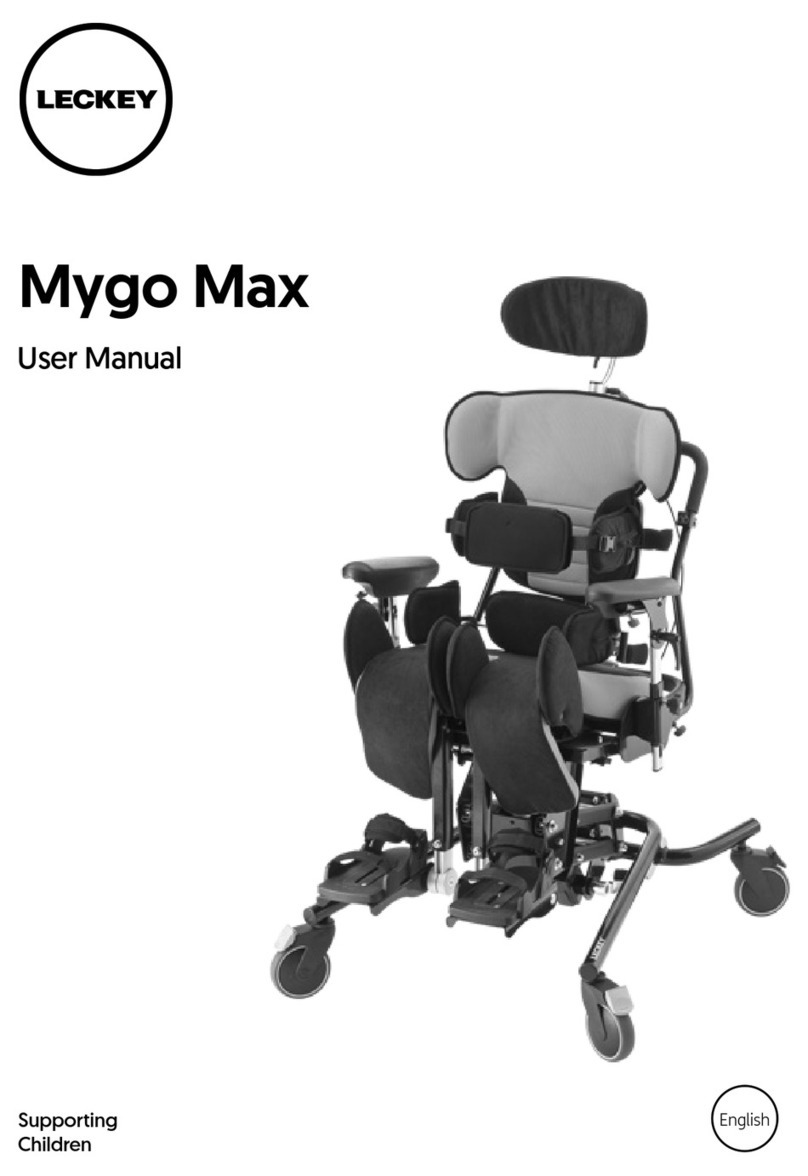
Leckey
Leckey Mygo user manual

Pegasus Zorg
Pegasus Zorg VARIA user manual

Sunrise Medical
Sunrise Medical Quickie XTR User instruction

Pressalit
Pressalit PLUS shower seat 450 Operation and maintenance manual

Invacare
Invacare 9000 Topaz Owner's operator and maintenance manual
